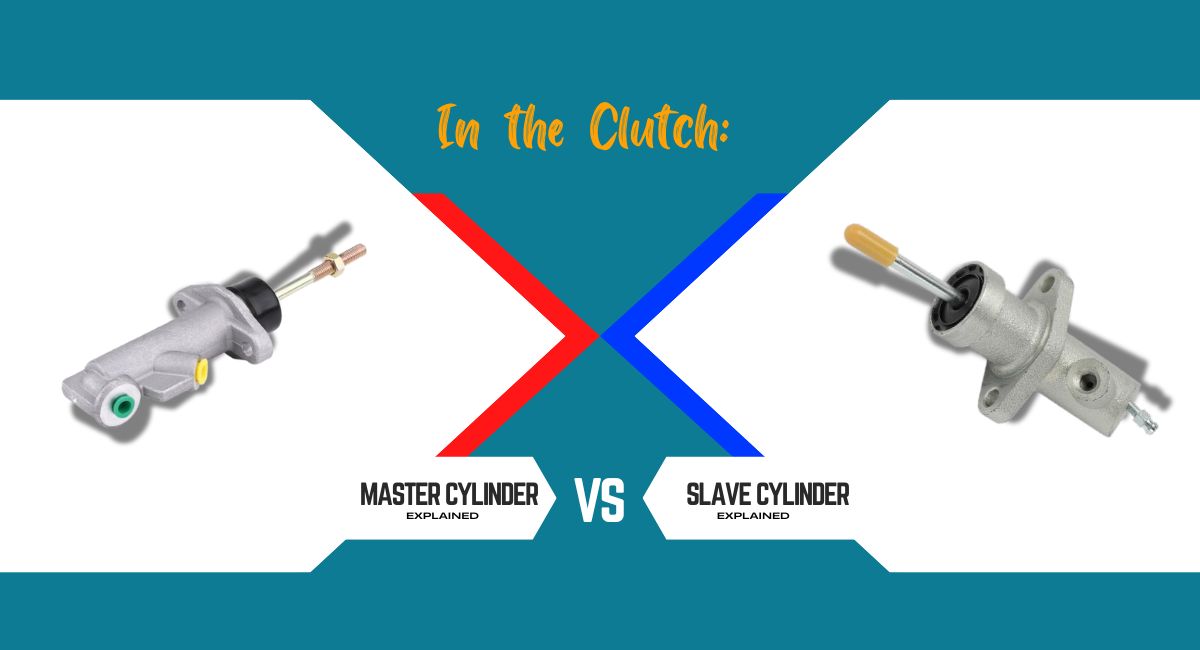The clutch system in a manual transmission vehicle is an intricate yet essential mechanism that enables drivers to connect and disconnect the engine’s power to the wheels. Central to this system are the master cylinder and slave cylinder, components that work together to transfer the force applied to the clutch pedal into action at the clutch assembly. Whether you’re a car enthusiast, a DIY mechanic, or a curious driver, understanding the functions, maintenance, and potential issues of these components is crucial for optimal vehicle performance.
The Basics of Hydraulic Clutch Systems
Hydraulic clutch systems have largely replaced mechanical linkages due to their superior performance and reliability. These systems rely on the principles of hydraulics, which use incompressible fluid to transfer force with minimal energy loss.
How Hydraulic Systems Work
- Force Transmission: Pressing the clutch pedal activates the master cylinder, which converts mechanical force into hydraulic pressure. This pressure travels through a fluid-filled line to the slave cylinder.
- Action Execution: The slave cylinder uses this pressure to engage or disengage the clutch, allowing for smooth gear changes.
Why Choose Hydraulic Over Cable Systems?
- Smooth Operation: Hydraulic systems provide consistent and precise clutch engagement, reducing the effort required from the driver.
- Self-Adjusting Mechanism: Unlike cable-operated systems that require frequent adjustments, hydraulic clutches automatically compensate for clutch plate wear.
- Durability: With fewer moving parts, hydraulic systems are less prone to mechanical failure and wear.
The Master Cylinder: The Control Hub
The master cylinder is the starting point of the hydraulic clutch system, translating the driver’s input on the clutch pedal into hydraulic pressure.
How It Works
When you press the clutch pedal, a piston inside the master cylinder compresses the hydraulic fluid. This creates pressure that moves through the fluid line to the slave cylinder.
Key Components
- Reservoir: Holds the hydraulic fluid, usually located near the engine bay for easy access.
- Piston: Compresses the fluid to generate pressure.
- Seals: Prevent leaks and ensure efficient operation.
Common Issues
- Leaking Fluid: A major cause of clutch failure; visible near the firewall or under the dashboard.
- Air Bubbles: Result in a spongy or unresponsive pedal.
- Internal Wear: Over time, seals can degrade, reducing the cylinder’s ability to maintain pressure.
Real-World Scenario:
A driver notices their clutch pedal sinking to the floor with minimal resistance. Upon inspection, they find hydraulic fluid leaking near the pedal. This is a classic symptom of a failing master cylinder, requiring immediate replacement to avoid further issues.
The Slave Cylinder: The Action Executor
The slave cylinder is located near the clutch assembly, tasked with converting hydraulic pressure into the mechanical motion needed to engage or disengage the clutch.
How It Works
The hydraulic pressure from the master cylinder pushes a piston within the slave cylinder. This piston either moves a clutch fork or directly engages a concentric release bearing to operate the clutch.
Types of Slave Cylinders
- External Slave Cylinder: Mounted outside the transmission and easier to replace.
- Concentric Slave Cylinder (CSC): An integrated design combining the slave cylinder and release bearing, often found inside the transmission housing.
Common Issues
- Leaks: Often caused by worn seals, leading to reduced hydraulic pressure.
- Sticking Pistons: Prevent smooth clutch operation, causing difficulty in gear shifting.
- Contaminated Fluid: Dirt or moisture in the fluid can corrode internal components.
Maintenance Tip: Always inspect the slave cylinder during clutch servicing, as replacing a failed unit typically involves significant labor.

Key Differences Between Master and Slave Cylinders
Understanding the differences between these components is essential for diagnosing and resolving clutch issues.
| Aspect | Master Cylinder | Slave Cylinder |
| Function | Converts pedal force into hydraulic pressure. | Converts hydraulic pressure into mechanical action. |
| Location | Near the clutch pedal in the engine bay. | Near the clutch assembly, often on or inside the transmission. |
| Symptoms of Failure | Spongy pedal, fluid leaks near pedal area. | Difficulty disengaging clutch, leaks near transmission. |
| Replacement Cost | Generally lower due to easier access. | Can be higher due to labor-intensive placement. |
Diagnosing Clutch Cylinder Issues
Identifying problems early can prevent costly repairs and ensure safe driving.
Common Symptoms
- Soft or Spongy Pedal: Indicates air in the hydraulic lines or a failing master cylinder.
- Clutch Slippage: A sign that the slave cylinder may not fully disengage the clutch.
- Leaking Fluid: Look for puddles under the vehicle, near the firewall (master cylinder) or transmission (slave cylinder).
DIY Diagnostic Steps
- Inspect Fluid Levels: Check the reservoir for adequate and clean fluid.
- Look for Leaks: Examine hydraulic lines and cylinder connections for visible leaks.
- Bleed the System: Remove air bubbles to restore hydraulic pressure.
Maintaining Master and Slave Cylinders
Regular maintenance can prolong the lifespan of these components and enhance vehicle performance.
Fluid Care
- Replace clutch fluid every 2–3 years or as recommended by the manufacturer.
- Use the specified type of fluid (e.g., DOT 3, DOT 4).
- Avoid contamination by keeping the reservoir sealed.
Inspection and Early Action
- Check for wear or damage during routine servicing.
- Address minor leaks promptly to prevent system failure.
Preventative Measures:
- Avoid prolonged use of a spongy or unresponsive clutch pedal, which can lead to further damage.
- If one cylinder fails, consider replacing both, as they often wear out simultaneously.
Replacement Process and Cost
Replacing a clutch cylinder is a straightforward process, though the labor can be intensive, especially for internal slave cylinders.
Replacement Steps
- Drain Old Fluid: Prevent contamination during the replacement process.
- Remove Faulty Cylinder: Disconnect hydraulic lines and unbolt the cylinder.
- Install New Cylinder: Secure the replacement and reconnect the lines.
- Refill and Bleed System: Use fresh fluid and bleed air from the system to ensure proper pressure.
Costs to Consider
- Master Cylinder: $50–$150 for parts, $150–$300 for labor.
- Slave Cylinder: $50–$250 for parts, $200–$400 for labor.
- DIY replacements can significantly reduce costs but require proper tools and knowledge.
Advances in Clutch Technology
Modern advancements are enhancing the reliability and performance of hydraulic clutch systems.
Self-Adjusting Clutches
- Automatically compensate for wear, reducing maintenance.
- Improve pedal feel over the clutch’s lifespan.
Dual-Clutch and Semi-Automatic Systems
- Combine the efficiency of manual transmissions with the convenience of automatics.
- Use advanced hydraulic systems for faster, smoother shifts.
Durability Improvements
- Use of high-strength materials, such as composites and reinforced plastics, for extended lifespan.
Environmental Considerations
Hydraulic fluid is classified as hazardous waste and must be disposed of responsibly.
Best Practices
- Recycle old fluid at authorized collection centers.
- Opt for biodegradable fluids to reduce environmental impact.
Frequently Asked Questions (FAQs)
Q: How can I tell if my clutch problem is due to the master or slave cylinder?
A: Master cylinder issues typically cause a spongy pedal or fluid leaks near the pedal area. Slave cylinder problems usually result in difficulty disengaging the clutch or leaks near the transmission.
Q: Should I replace the clutch cylinders myself?
A: While DIY is possible for external components, professional service is recommended for concentric slave cylinders due to their complex placement.
Q: How often should clutch fluid be replaced?
A: Replace every 30,000–60,000 miles or as advised in the vehicle’s maintenance guide.
Q: Can I drive with a failing clutch cylinder?
A: Driving with a failing cylinder can cause further damage and lead to unsafe driving conditions. Address issues promptly.
Conclusion
Master and slave cylinders are vital components of a hydraulic clutch system, ensuring seamless power transfer and smooth driving. Understanding their roles, maintaining them properly, and addressing issues promptly can save you time and money while enhancing vehicle safety and performance.
Stay vigilant for signs of wear, keep your hydraulic system well-maintained, and enjoy a worry-free driving experience.
